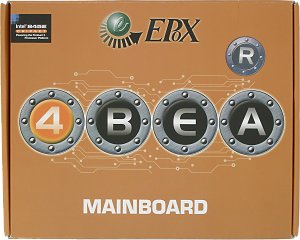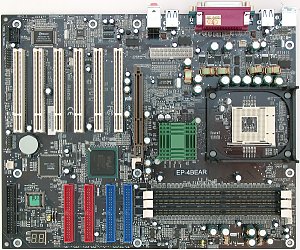EPoX 4BEAR
(i845E) Mainboard
|

The characteristic 7-segment LEDs of a POST controller, as well as the IDE
RAID on the HighPoint's chip give away the authorship. Accessories:
- Package of a new design;
- Documentation: user manual in
English;
- Cables: 1 ATA66/100/133 and FDD;
- Bracket
with a Game port;
- Bracket for the rear computer panel;
-
Diskette with drivers for the IDE RAID;
- 2 CDs containing:
- drivers;
- system monitoring programs;
- DirectX
7.0a;
- Adobe Acrobat Reader;
- Boostek;
-
Norton Ghost 7.0;
- PC-Cillin 2000;
- Power Quest Drive
Image 4.0;
- Power Quest Partition Magic SE 6.0.

The layout is not very good: the IDE RAID connectors are behind the PCI slots
while the audio-ins are in front of them. The FDD connector located on the left
edge will hinder cooling of the computer, and an inserted video card creates difficulties
in handling memory modules. It's not difficult to reach the jumpers when the board
is already installed. Their functions are shown on the textolite. The 3-channel
switching voltage regulator incorporates 8 capacitors of 3300 uF and 3 of 2200
uF. The following controllers are integrated: - audio controller
based on the chipset's capabilities and ALC650 AC'97 codec supporting 5.1 audio
systems and with an SPDIF connector;
- IDE RAID controller on the
HighPoint HPT372 chip supporting RAID 0, 1 and 0+1 on the ATA133 protocol.
There
are two 7-segment LEDs for the POST controller. Non-unsoldered connectors:
none. The system monitoring is supported by the Winbond WT83627HF-AW
chip. What is controlled: - processor voltage, +3.3, +-5 and +-12 V, VBAT,
+5 V Standby;
- speed of 3 fans;
- temperatures of the
processor (a built-in sensor), and the board (a built-in sensor).
There
are 3 connectors for adjustable connection of fans. Brief characteristics
of the board: memory slots - 3 DDR SDRAM; expansion slots - AGP/ 6 PCI; I/O
ports - 2 COM/ LPT/ 2 PS/2/ 6 USB 2.0; dimensions - 305x245 mm.

Adjustment
can be carried out with:
| jumpers and switches | Jumper
to clear up the CMOS | | | Jumpers for changing
Vmem | 2.5, 2.6 (Default), 2.7, 2.8 and 2.9 V | | BIOS
based on 6.00PG from Phoenix-Award | Setup of memory timings | + | CAS
Latency, Active to Precharge Delay, RAS to CAS Delay, RAS Precharge |
| Setup of memory frequency | + | Auto, CPU:DRAM=1:1,
3:4 | | Setup of AGP bus | - | |
| Setup of PCI bus | - | | | Changeable
scaler of AGP and PCI buses | + | Auto, AGP (PCIx2) =
66 MHz, 2/3 FSB | | Manual assignment of interrupts | + | |
| Changeable FSB frequency | + | 90 - 200 MHz in
1MHz steps | | Changeable CPU multiplier | + | x8
- x50 | | Changeable core voltage | + | from
-0.1 to +0.35 V in 0.025V steps | | Changeable memory voltage | - | |
| Changeable chipset voltage | - | | | Changeable
AGP bus voltage | + | from +0.1 to +0.4 V in 0.1V steps |
We used the latest available version of the BIOS of 22/07/2002.
It's not an ordinary board, but at the same time, it is typical of the company:
a good set of functions and a wealth of rich settings. Test results:
Write a comment below. No registration needed!
|
|



